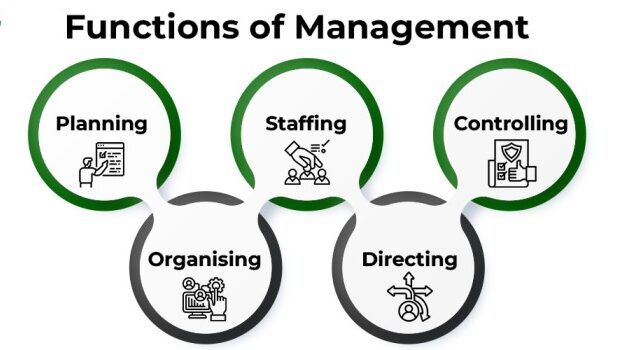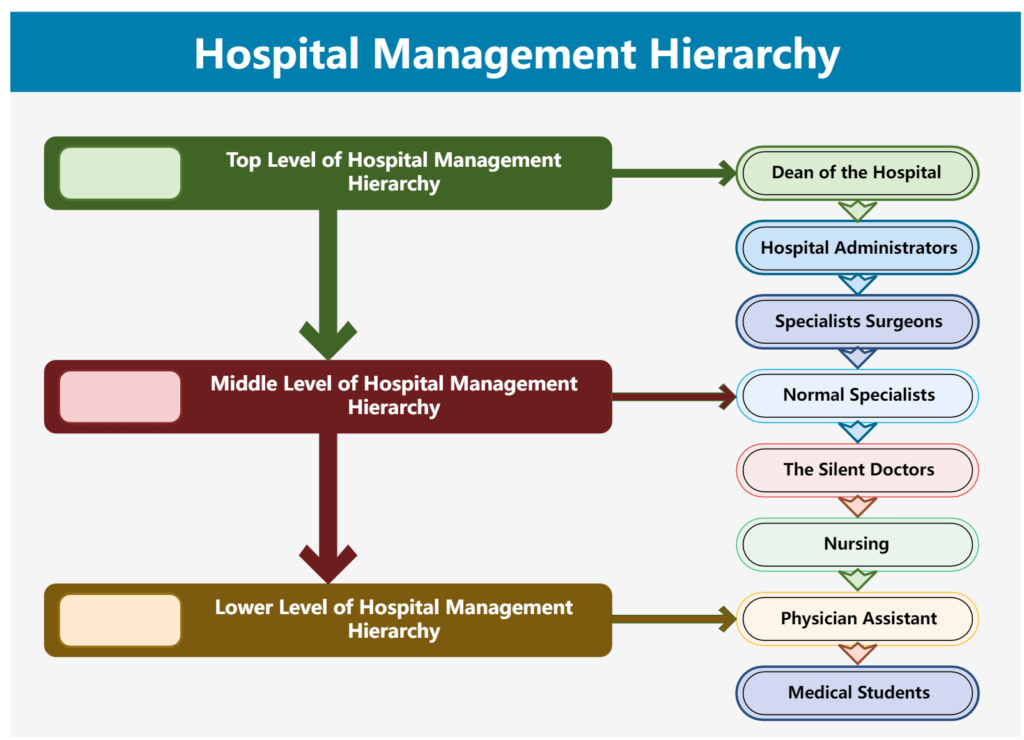Table of Contents
ToggleLevels of Hospital Management
Levels of Hospital Management refers to the line of division that exists between various managerial positions in a hospital.
As the size of the hospital and workforce increases, the number of levels in management increases along with it, and vice versa. The different Levels of Hospital Management can determine the chain of command within a hospital, as well as the amount of authority and usually decision-making influence accumulated by all managerial positions.
Levels of Hospital Management can be generally classified into three principal categories, all of which direct managers to perform different functions.
1. Administrative, Managerial, or Top Level of Hospital Management:
This level of management consists of a hospital’s board of directors and the chief executive or medical director.
It is the ultimate source of power and authority, since it oversees the goals, policies, and procedures of a hospital. Their main priority is on the strategic planning and execution of the overall hospital’s success.
The roles and responsibilities of the top level of hospital management can be summarized as follows:
- Laying down the objectives and broad policies of the hospital enterprise.
- Issuing necessary instructions for the preparation of department-specific budgets, schedules, procedures, etc.
- Preparing strategic plans and policies for the hospital.
- Appointing the executives for middle-level management, i.e. departmental managers.
- Establishing controls of all hospital departments.
- Since it consists of the Board of Directors, the top management level is also responsible for communicating with the outside world and is held accountable towards a hospital’s stakeholders for the performance of the enterprise.
- Providing overall guidance, direction, and encouraging harmony and collaboration.
2. Executive or Middle Level of Hospital Management:
The branch and departmental managers form this middle management level.
These people are directly accountable to top management for the functioning of their respective departments, devoting more time to organizational and directional functions. For smaller hospitals, there is often only one layer of middle management, but larger hospitals can see senior and junior levels within this middle section.
The roles and responsibilities of the middle level of hospital management can be summarized as follows:
- Executing the plans of the hospital in accordance with the policies and directives laid out by the top management level.
- Forming plans for the sub-units of the hospital that they supervise.
- Participating in the hiring and training processes of lower-level management.
- Interpreting and explaining the policies from top-level management to lower-level management.
- Sending reports and data to top management in a timely and efficient manner.
- Evaluating the performance of junior managers.
- Inspiring lower level managers towards improving their performance.
3. Supervisory, Operative, or Lower Level of Hospital Management:
This level of management consists of supervisors, nurses, section officers, superintendents, and all other executives whose work must do largely with HR oversight and the direction of operative employees.
Simply put, managers at the lower level are primarily concerned with the execution and coordination of day-to-day workflows that ensure completion of patient care and that deliverables are met.
The roles and responsibilities of the lower level of hospital management can be summarized as follows:
- Assigning patients and tasks to various staff members.
- Guiding and instructing staff members in day-to-day activities.
- Overseeing both the quality and quantity of patient care.
- Maintaining good relations within lower levels of the hospital.
- Acting as mediators by communicating the problems, suggestions, and recommendatory appeals, etc. of staff members to the higher level of management, and in turn elucidating higher-level goals and objectives to staff members.
- Helping to address and resolve the grievances of staff members.
- Supervising and guiding their subordinates.
- Taking part in the hiring and training processes of their staff members.
- Arranging the necessary medical supplies, equipment, tools, and resources, etc. necessary for accomplishing hospital tasks.
- Preparing periodical reports regarding the performance of the staff members.
- Upholding discipline, decorum, and harmony within the workplace.
- Improving the hospital’s image as a whole, due to their direct contact with the staff members.

Functions of management.
Henri Fayol also described the functions of management as
- Planning
- Organizing
- Directing or Leading
- Staffing
- Controlling.
As discussed earlier, a healthcare manager is required to juggle a variety of responsibilities. Henri Fayol in 1916/Luther Gullick put forward the functions of an executive/manager as POSDCORB. POSDCORB is an acronym for Planning, Organizing, Staffing, Directing, Coordinating, Reporting, and Budgeting. It was created in 1937 by members of President Roosevelt’s administrative committee, Luther Gulick and Lyndall Urwick.
Management has five main functions or steps that universally comprise the management process.

Planning
Planning in management refers to forecasting what is needed for the future, setting objectives for the desired results and developing strategies to achieve these goals. It is the first management function and all other functions depend on it.
Planning is a decision-making activity that involves the process of determining objectives and deciding on specific actions to achieve those objectives.
Planning is the process of preparing for change and coping with uncertainty by formulating future courses of action.
Planning is particularly crucial due to scarce resources, uncertain environments, and competition for those resources.
Reasons for Planning/Purpose of Planning:
- To successfully achieve organizational goals and objectives through established strategies.
- To ensure effective resource utilization, including human resources, to prevent resource wastage.
- To better cope with situational crises since these were anticipated and planned for.
- To ensure effective control of resources, especially human resources.
- To guide decision-making by specifying the actions and steps to be taken to achieve organizational goals. This enables managers to make informed decisions on current and future activities.
- To anticipate problems and facilitate a smooth flow of organizational operations.
- To identify gaps and areas requiring change, which can be addressed for the betterment of the organization. This can be achieved through periodic reviews of organizational activities.
- To give meaning to work since employees will work towards a well-defined goal.
Characteristics of a Good Plan:
- Simplicity and Comprehensiveness: A good plan should be simple and comprehensive so that all employees can grasp its significance and easily put it into action. It should also be detailed enough to cover all aspects of the operation necessary to achieve the objectives.
- Clear and Well-Defined Objectives: A good plan should have clear, well-defined, and easily understood objectives.
- Balance and Flexibility: A good plan should be well-balanced and flexible. Existing resources should be allocated for proper utilization, ensuring that short-term gains are not achieved at the cost of long-term gains. It should also be flexible enough to incorporate any changes in resources.
- Time-Bound: A good plan should be established for a specific period of time.
- Actionable: A good plan should have set out strategies for achieving organizational goals that are practical and actionable.
- Involvement of Subordinates: A good plan should incorporate all departments within the organization to promote unity and focus on the overall objective. This involves participation by subordinates.
Principles of Effective Planning:
- Clear, Reasonable, and Attainable Aims: The aims of the organization in the plan must be clear, reasonable, and attainable. Unrealistic goals can lead to failure and demotivation.
- Involvement of Subordinates: Subordinates should be involved in the planning process to ensure their acceptance of the plans and their commitment to implementing them.
- Assigning Planning Responsibility: Planning responsibility should be assigned to the right people, those who are directly involved with the operation and have the necessary expertise.
- Realism in Anticipated Results: Planners should be realistic in their anticipation of results. They should not be overly optimistic but should base their plans on a realistic assessment of the organization’s capabilities and resources.
- Flexibility and Constant Review: Plans should be flexible and subject to constant review and adjustment as needed. The dynamic nature of the business environment requires plans to be adaptable to changing circumstances.

Levels of Planning:
1. Strategic Planning/Long-Term Planning:
- Conducted by top management (CEOs, directors, presidents, vice presidents).
- Involves determining the direction in which the organization should be run.
- Long-range/term planning (a period of up to 10 years).
- Deals with the total assessment of the organization’s capabilities, strengths, and weaknesses.
2. Tactical/Intermediate Planning:
- Covers a time frame of about 6 months to 2 years.
- Conducted by middle management (department heads).
- Middle managers refine broad objectives into more workable and realistic plans.
Operational Planning:
- The responsibility of lower management (unit supervisors).
- Short-range plans covering a time span from 1 week to one year.
- More specific and determine how a specific job is to be completed in the best way.
These different levels of planning are interconnected and contribute to the overall success of the organization. Strategic planning provides the foundation for intermediate and operational planning, which in turn support the achievement of the organization’s long-term goals
Planning Process/Steps in Planning:
1. Assessment: Involves collecting adequate data about the organization to answer questions such as: Where are we? What do we have to work with? Where do we want to be? How do we get there?
- Analyze and interpret the information as a meaningful whole.
- Identify the organization’s needs, strengths, and weaknesses.
2. Establish and Clearly Define Goals/Objectives:
- This portion of the planning process should include a detailed overview of each goal, including:
- The reason for its selection
- The anticipated outcomes of goal-related projects
- Example: The objective of a hospital is to provide quality healthcare.
3. Identify Resources:
- Each goal should have financial and human resources attached for its achievement or completion.
4. Priority Setting:
- Prioritize the objectives and resources based on their importance.
- Approach and complete the most important tasks first.
- Consider the steps necessary to complete a task or achieve a goal.
5. Development of Strategies:
- Set up measures for the achievement of the organizational objectives.
- Assign a timeline for the achievement/accomplishment of each task.
- Consider the abilities of the staff when assigning duties or work.
- Formulate policies, rules, and regulations to control organizational activities.
6. Implementation of the Plan:
- The action stage of the planning process.
- Implement all the identified strategies to achieve the organizational goals.
- Requires a combination of all skills and coordination of all factors.
7. Evaluation of the Plan:
- Re-evaluate the plan periodically to measure its progress and effectiveness.
- Correct any deviations and make adjustments where necessary.
- Request monthly progress reports from department heads.

Benefits of Planning:
- Performance Standards: Planning provides performance standards that assist in the development of potential and standards for measuring the progress of the organization. Essential in organizational control.
- Improved Competitive Strength: Deviations are easily identified based on set standards and addressed accordingly.
- Reduced Risk and Uncertainty: Anticipate risks and uncertainties early on, Develop strategies to overcome them.
- Effective Resource Utilization: Proper planning promotes effective utilization of organizational resources, minimizing wastage.
- Future Focus: Planning enables managers to focus on the future rather than the present, giving them purpose and direction.
- Framework for Decision-Making: Knowing the organizational objectives and methods to achieve them eliminates ambiguity in the decision-making process.
- Motivation for Workers: Proper planning motivates workers, especially if they are involved in the planning process.

